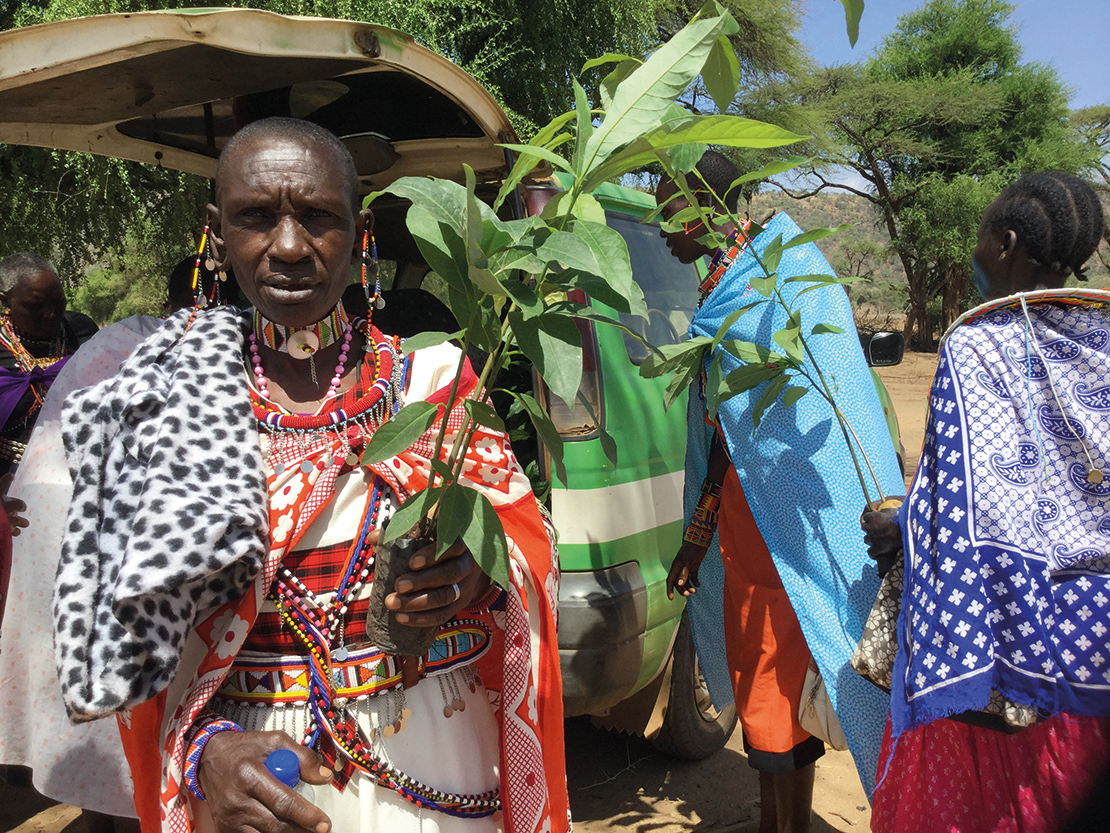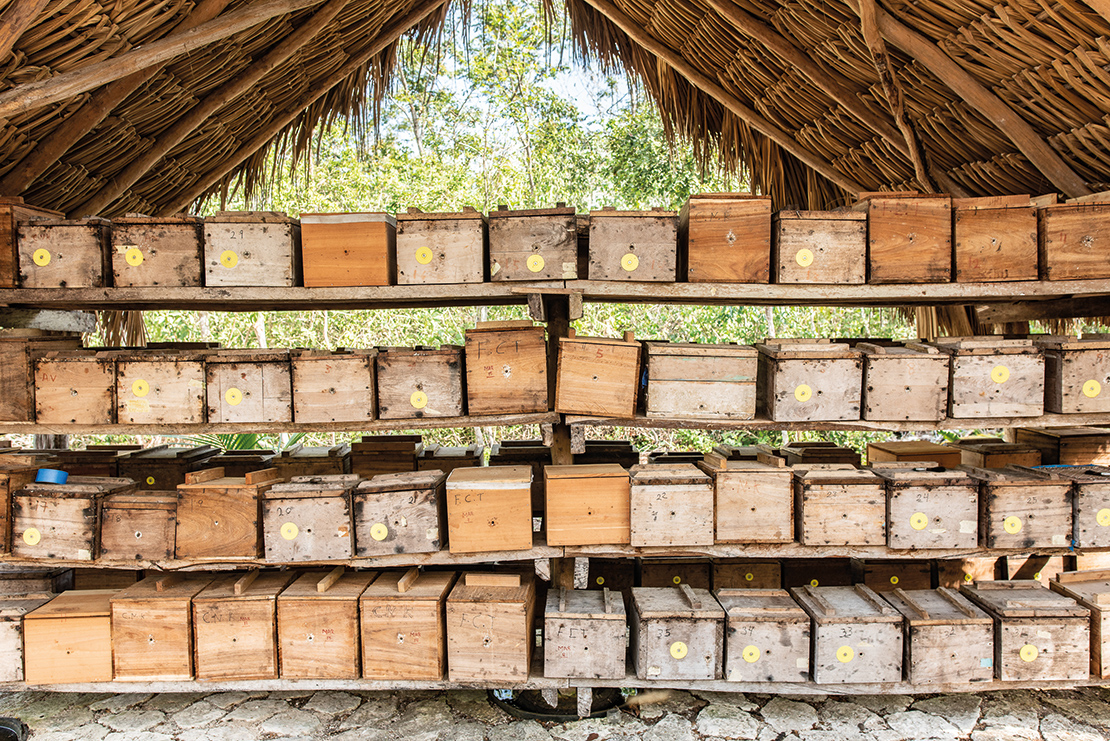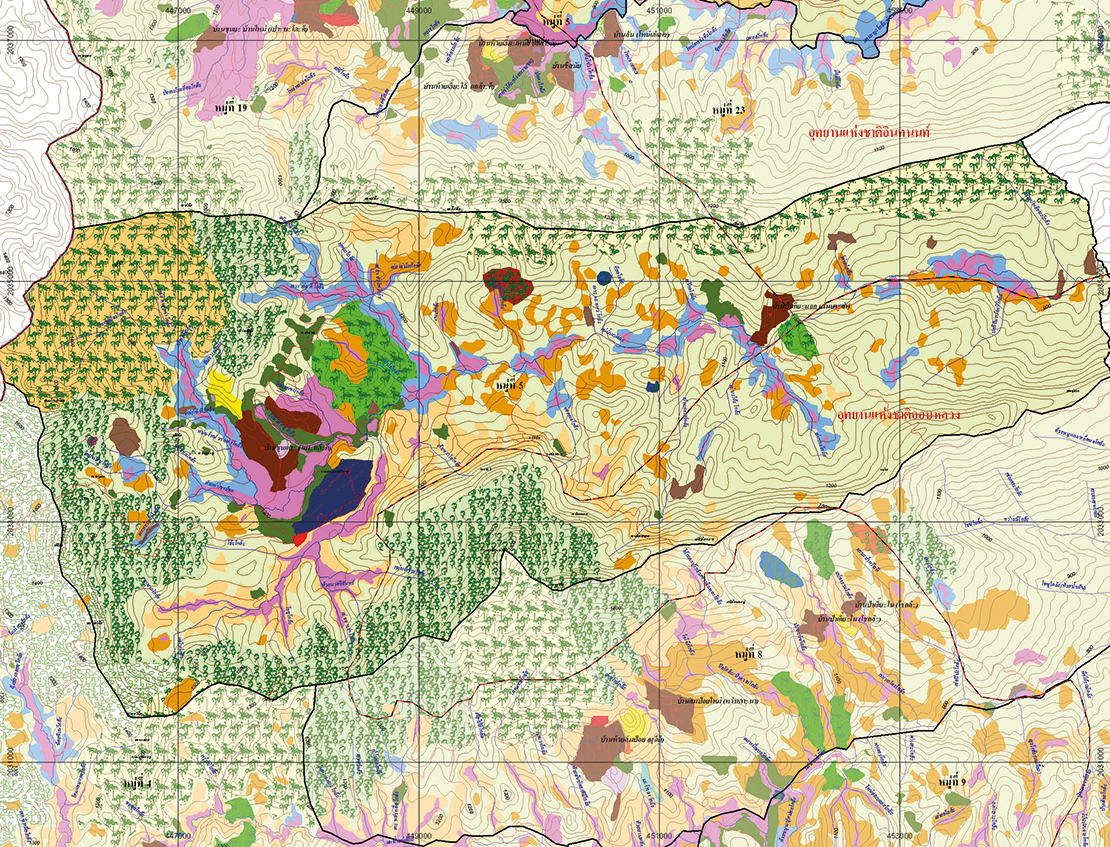
Target 14: Ecosystem services
By 2020, ecosystems that provide essential services, including services related to water, and contribute to health, livelihoods and well-being, are restored and safeguarded, taking into account the needs of women, indigenous and local communities, and the poor and vulnerable.
Key messages
- For IPLCs, ecosystems and habitats that provide ‘essential services’ are their customary lands, territories, waters and resources, which fulfil their livelihood, spiritual and cultural needs.
- Secure IPLC land tenure is fundamental to progress on achieving this target and is critical not only for IPLCs but for their continued substantial vital contributions to the whole of humanity.
- IPLC women play important roles and hold distinct rights as knowledge holders and resource managers.
Significance of Target 14 for IPLCs
Customary land tenure systems of IPLCs have co-evolved in all biomes on Earth, embodying dynamic, ecosystem-based and culture-based resource management systems for fulfilling human needs. Securing these ‘territories of life’ is a cross-cutting theme for many Aichi Biodiversity Targets, but is perhaps most relevant to Target 14. Secure land tenure is a prerequisite for restoring and safeguarding nature’s contributions to women, IPLCs and people in impoverished and vulnerable situations, which are integral to their health, wellbeing and livelihoods. It is also a prerequisite for the maintenance of natural and social resilience. However, the experiences of IPLCs as they strive to defend and secure their lands and territories continue to be marred by hostility and persecution. This has severe ecological, social and cultural consequences, distinctly for women and men, given their differentiated gender roles, responsibilities and opportunities with regards to ecosystem governance and management.1

Maasai medicine woman.
“Indigenous women are keepers of our natural resources. As a medicine woman I have to go far away to look for medicinal plants; we do not even have a forest anymore near us. I am even thinking of creating a small forest in my home. Am glad as indigenous women we are working together to share knowledge and have these plants just next to our kitchen gardens. We have the first step. We need you all to work with us and us with you.”
— Nailepu Naiguta, a Maasai medicine woman from Paran women’s group Ololulung, Narok, Kenya
Contributions and experiences of IPLCs towards Target 14
The figures related to customary ownership of the world’s land are staggering. At least half of the world’s land area is estimated to be under indigenous and community tenure.2 One quarter of the world’s land area (about 38 million square kilometres) is under the customary ownership and management of indigenous peoples.3 Up to 2.5 billion people make their living in rural economies through the stewardship of community forests and other community lands that play an essential role in maintaining ecosystem services at the landscape level.4
These areas have very high significance for nature’s global contributions to people5 and yet only 10 per cent of IPLC lands are legally secured.6 IPLC contributions towards Target 14 include both the safeguarding of these lands and territories against multiple external drivers of environmental destruction, and also the measures they are taking to conserve, sustainably use, and restore them, with women playing a particularly important role.
IPLC actions to safeguard their lands and territories
IPLCs are taking significant action across the world to safeguard their lands and territories, and the nature and biodiversity found therein. Examples provided throughout this report and further examples include:
- In Cambodia, Bunong indigenous communities in Mondulkiri province claim that since a private company received a 70-year lease to some 2,386 hectares for a rubber plantation and agricultural products, their ancestral lands, traditions and customs, and their livelihoods that depend on local ecosystems, have been under threat.7 In 2018, the Cambodian Center for Human Rights reported that more than 800 families had been affected. After losing any hope of obtaining justice in Cambodia, the communities successfully filed a lawsuit against the company, Socfin-KCD, under French law on the basis that the plantation is funded by French firm Bolloré. In October 2019, community representatives appeared for questioning at the tribunal in Nanterre, France.8
- In Belize, the Maya have mounted several court cases to defend their lands and ecosystems against degradation from oil exploration, road construction and uncontrolled logging.9
- In Peru, the Shipibo-Conibo people have raised a court case against illegal deforestation of an area on their lands for conversion to oil palm.
- In Kalimantan, Indonesia, the Dayak community of Long Isun is opposing logging on their lands without consent.
- In Sabah, Malaysia, villagers around the Telaga River in Pitas are fighting against the clearfelling of mangroves for intensive shrimp production.
- In Guyana, the Wapichan have been waging a campaign over many years to safeguard their lands and forests from external threats, including from illegal mining.
- In Colombia, indigenous peoples are working to protect their lands and territories in the Cañamomo Lomaprieta Indigenous Resguardo from illegal extraction activities and are carrying out ecological restoration of damaged lands.

A Maya Q’eqchi attorney addresses the United Nations Permanent Forum on Indigenous Peoples Issues. Credit: Jamie Malcolm-Brown.
Box 32: Maya Leaders’ Alliance
Case study: Safeguarding lands and territories: court cases mounted by the Maya, Belize10
In the Toledo District of Belize, which is part of the Mesoamerican Biodiversity Hotspot, the Maya are stewards of an estimated 200,000 hectares of tropical rainforest, savannah and wetland ecosystems. In each Maya village, land and resource use follows sustainable stewardship practices, with areas reserved for farming, medicinal use, spiritual use, hunting, and conservation to sustain a healthy watershed.
— Read the full case study

Beehives in a Mayan community in Mexico. Credit: Alessandro Banchelli.
Actions for conservation, sustainable use and restoration
In addition to protecting their lands from externally driven destruction, many IPLCs actively conserve and manage nature, based on traditional knowledge and customary practices and on new approaches developed collaboratively with scientists.11 For example, the Maya people in Quintana Roo, Mexico, are actively restoring populations of balché and other native tree species, to ensure that sufficient food is available for bees (see Box 33).
Women may differ from men both in their reliance on nature and in their roles in management of nature, according to their different responsibilities and priorities. In certain cases, inequalities between women and men in access, control and ownership of land and natural resources, as well as socio-cultural barriers to economic opportunities for women, can mean that women are more dependent on local access to nature and are more vulnerable to the effects of environmental degradation.
In many societies, women are taking their own collective actions towards Target 14, asserting their distinctive roles as knowledge holders and protectors. Examples include:
- In Armenia, since 2011, the Berd Women’s Resource Centre Foundation has been working with rural communities and local women’s groups to address environmental degradation in the Tavush region. The Centre focuses on gender equality and women’s unemployment, and promotes women’s empowerment and self-employment opportunities by engaging local women in the sustainable harvesting of wild plants. In addition, some 2,000 shrubs have been planted. The Centre teaches women how to process the plants and sell them to generate income. This project has also involved the sale of wild berry jams and jellies, and 80 women have benefitted indirectly through participation in training and workshops.12
- In the Dolakha district of Nepal, women play essential roles in community forests, using their knowledge and experience to develop effective strategies to conserve, manage and use the forests. As a result of these success stories, women are increasingly being recognised as important actors engaged in biodiversity conservation in this region.13
- In Egypt, the Bedouins in Wadi Allaqi Biosphere Reserve are facing challenges to adapt to their new environment after being resettled away from their homelands of Lake Nasser in 2002. Their tradition of agro-pastoralism was restricted in the reserve and it is expected that the new generation will gradually lose their traditional knowledge. Despite these difficulties, women are still trying to ensure that their experience and knowledge about medicinal plants, food, and grazing resources and adaptations as a result of their resettlement are sustained and contribute to their community’s sustainable livelihoods.14
Figure 4: A community map created by the Pga k’nyau (Karen) community of Khun Tae, in northern Thailand. The detailed land use patterns revealed in the map show that 47% of the 6,064 acres land area is customary
use forests, 11.2% for farming and 38.2% is under strict community protection.
Source: IMPECT

Box 33: Federación Indígena Empresarial y Comunidades Locales de México, A.C. (CIELO) y Sociedad Cooperativa Lool Xaam SC de RL de CV
Case study: El Balché: Sacred trees and bees of the Maya people, Mexico
Beekeeping is an important source of foreign exchange in our country and a source of income for much of the Maya community of Felipe Carrillo Puerto, Quintana Roo. However, it has decreased because of the low price paid to honey producers. In addition, populations of pollen- and nectar-producing trees have decreased in the area as a result of forest resource exploitation, so the quantity and quality of honey has also decreased. Therefore, it is necessary to monitor the hives constantly, and also to monitor and reforest the flora around beekeeping farms, to ensure a supply of pollen and nectar for the bees.
— Read the full case study
Opportunities and recommended actions
- IPLCs should continue to defend their collective lands and territories, and upscale partnerships with relevant actors to secure customary land tenure, paying particular attention to women’s cultural and socio-economic context and distinct rights.
- Governments should fulfil their human rights obligation to respect and protect the rights of IPLCs to their lands, territories, waters and resources, and to promote health, livelihoods and wellbeing for women, the poor and the vulnerable, leaving no one behind.
- Governments and relevant actors should respect IPLC cultural and material values, their spiritual relationships with sacred sites, culturally important species, and other contributions of nature to people.
Key resources
- Sangha, Kamaljit, K., Russell-Smith, J. and Costanza, R. (2019) ‘Mainstreaming indigenous and local communities’ connections with nature for policy decision-making’, Global Ecology Conservation (19). Available at: https://www.sciencedirect.com/science/article/pii/S235198941930229X
- IPBES (2019) Summary for policymakers of the global assessment on biodiversity and ecosystem services of the Intergovernmental Science-Policy Platform on Biodiversity and Ecosystem Services. S. Díaz, J. Settele, E. S. Brondízio E.S., H. T. Ngo, M. Guèze, J. Agard, A. Arneth, P. Balvanera, K. A. Brauman, S. H. M. Butchart, K. M. A. Chan, L. A. Garibaldi, K. Ichii, J. Liu, S. M. Subramanian, G. F. Midgley, P. Miloslavich, Z. Molnár, D. Obura, A. Pfaff, S. Polasky, A. Purvis, J. Razzaque, B. Reyers, R. Roy Chowdhury, Y. J. Shin, I. J. Visseren-Hamakers, K. J. Willis, and C. N. Zayas (eds.). Bonn, Germany: IPBES. Available at: https://doi.org/10.5281/zenodo.3553579
- Indigenous Peoples Major Group for Sustainable Development (n.d.) ‘Global report on the situation of lands, territories and resources of indigenous peoples’. IPMG. Available at: https://www.indigenouspeoples-sdg.org/index.php/english/all-resources/ipmg-position-papers-and-publications/ipmg-reports/global-reports/116-global-report-on-the-situation-of-lands-territories-and-resources-of-indigenous-peoples/file
- Pearce, F (2016) ‘Common Ground. Securing land rights and safeguarding the Earth’. Oxford: Oxfam, International Land Coalition, Rights and Resources Initiative. Available at: https://policy-practice.oxfam.org.uk/publications/common-ground-securing-land-rights-and-safeguarding-the-earth-600459
References
- Global Land Tool Network. Available at: https://gltn.net/
- Right and Resources Initiative (2015) Who owns the world’s land? A global baseline of formally recognized indigenous and community land rights. Washington D.C.: Rights and Resources Initiative. Available at: https://rightsandresources.org/wp-content/uploads/GlobalBaseline_web.pdf
- IPBES (2019) Summary for policymakers of the global assessment on biodiversity and ecosystem services of the Intergovernmental Science-Policy Platform on Biodiversity and Ecosystem Services. S. Díaz, J. Settele, E. S. Brondízio E.S., H. T. Ngo, M. Guèze, J. Agard, A. Arneth, P. Balvanera, K. A. Brauman, S. H. M. Butchart, K. M. A. Chan, L. A. Garibaldi, K. Ichii, J. Liu, S. M. Subramanian, G. F. Midgley, P. Miloslavich, Z. Molnár, D. Obura, A. Pfaff, S. Polasky, A. Purvis, J. Razzaque, B. Reyers, R. Roy Chowdhury, Y. J. Shin, I. J. Visseren-Hamakers, K. J. Willis, and C. N. Zayas (eds.). Bonn, Germany: IPBES. Available at: https://doi.org/10.5281/zenodo.3553579
- Rights and Resource Initiative (2017) Securing community land rights: priorities and opportunities to advance climate and sustainable development goals. Washington D.C.: Rights and Resource Initiative. Available at: https://rightsandresources.org/wp-content/uploads/2017/09/Stockholm-Prorities-and-Opportunities-Brief.pdf
- IPBES (2019) Summary for policymakers of the global assessment on biodiversity and ecosystem services of the Intergovernmental Science-Policy Platform on Biodiversity and Ecosystem Services. S. Díaz, J. Settele, E. S. Brondízio E.S., H. T. Ngo, M. Guèze, J. Agard, A. Arneth, P. Balvanera, K. A. Brauman, S. H. M. Butchart, K. M. A. Chan, L. A. Garibaldi, K. Ichii, J. Liu, S. M. Subramanian, G. F. Midgley, P. Miloslavich, Z. Molnár, D. Obura, A. Pfaff, S. Polasky, A. Purvis, J. Razzaque, B. Reyers, R. Roy Chowdhury, Y. J. Shin, I. J. Visseren-Hamakers, K. J. Willis, and C. N. Zayas (eds.). Bonn, Germany: IPBES. Available at: https://doi.org/10.5281/zenodo.3553579
- Right and Resources Initiative (2015) Who owns the world’s land? A global baseline of formally recognized indigenous and community land rights. Washington D.C.: Rights and Resources Initiative. Available at: https://rightsandresources.org/wp-content/uploads/GlobalBaseline_web.pdf
- AsiaNews EN (2019) ‘Cambodian indigenous group files lawsuit against French company over seized land’. AsiaNews. Milan: AsiaNews EN. Available at: http://asianews.it/news-en/Cambodian-indigenous-group-files-lawsuit-against-French-company-over-seized-land-46239.html
—
Kimmarita, L. (2019) ‘Bunong group attends French court hearing over land dispute’. Phnom Penh Post. Phnom Penh: The Phnom Penh Post. Available at: https://www.phnompenhpost.com/national/bunong-group-attends-french-court-hearing-over-land-dispute - Kimmarita, L. (2019) ‘Bunong group attends French court hearing over land dispute’. Phnom Penh Post Phnom Penh: The Phnom Penh Post. Available at: https://www.phnompenhpost.com/national/bunong-group-attends-french-court-hearing-over-land-dispute
- Torres, M. (2019) Maya Leaders Alliance (MLA), Belize. Equator Initiative Case Study Series. New York: Equator Initiative. Available at: https://www.equatorinitiative.org/wp-content/uploads/2019/02/MLA-Belize.pdf
- For more information on this case, see: https://www.equatorinitiative.org/wp-content/uploads/2019/02/MLA-Belize.pdf
- Trosper, R. L. (2002) ‘Northwest Coast indigenous institutions that supported resilience and sustainability’, Ecological Economics 41(2), pp. 329–44.
—
Garnett, S. T. et al. (2018) ‘A spatial overview of the global importance of Indigenous lands for conservation’, Nature Sustainability 1, pp. 369–74.
—
Norman, E. S. (2015) ‘Standing up for inherent rights: The role of Indigenous-led activism in protecting sacred waters and ways of life’, Society & Natural Resources: An International Journal 30, pp. 537-555. - GEF Partners (2018) Women as environmental stewards: The experience of the Small Grants Programme. Global Environment Facility. Available at: https://www.thegef.org/publications/women-environmental-stewards-experience-small-grants-programme
- Khadka, M. and Verma, R. (2012) Gender and biodiversity management in the Greater Himalayas: Towards equitable mountain development. Kathmandu: International Centre for Integrated Mountain Development. Available at: https://www.researchgate.net/publication/235823303_Gender_and_Biodiversity_Management_in_the_Greater_Himalayas_Towards_Equitable_Mountain_Development
- Yacoub, H. A. (n.d.) ‘Agro-pastoralism as strategy for sustainable conservation and livelihood in Wadi Allaqi Biosphere Reserve, South Eastern Desert, Egypt.’ London: Rufford Foundation. Available at: https://www.rufford.org/rsg/projects/hoda_yacoubKandal, H. A., Yacoub, H. A., Gerkema, M. P. and Swart, J. A. A. (2019) ‘Traditional knowledge and community resilience in Wadi Allaqi, Egypt’, Journal of Arid Environments 171.


